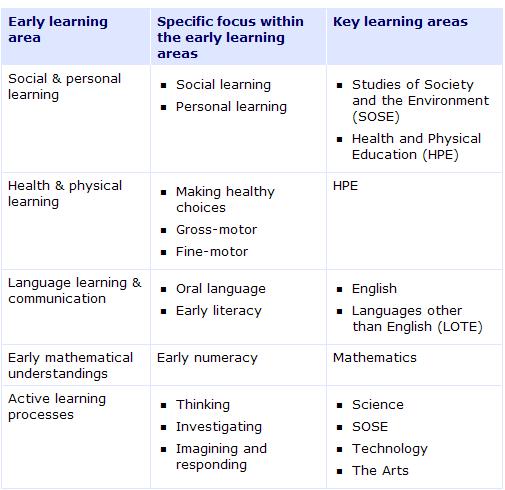Curricula pentru anul pregatitor
Se axeaza pe 6 factori care s-a aratat ca influenteaza abilitatile scolare necesare ( school readiness) si succesul scolar viitor :
Competente de ordin social si emotional/ social and emotional competence
sanatatea fizica / health and physical wellbeing
dezvoltarea limbajului si comunicare / language development and communication
intelegera timpurie a notiunilor matematice / early mathematical understandings
procese active de invatare cu accent pe gandire, investigatie( ratinament, judecata) si imaginatie , dispozitie pozitiva in legatura cu invatarea ( placerea de a invata) / active learning processes, with a focus on thinking, investigating, and imagining and responding positive dispositions to learning.
Desi a fost conceputa pentru anul pregatitor intrarii n clasa I curricula ofera un cadru larg de invatare care poate fi folosit pe parcursul an pregatitor/clasa a3-a / While the EYCG has been developed specifically for the Preparatory Year, it provides a framework for learning from Prep to Year 3.
Ce cuprinde aceasta pagina / On this page:
Cum invata copiii in perioada prescolara/ How children learn in the early phase of schooling
BAzele invatarii ulterioare / Foundations for later learning
Ce invata copiii in faza prescolara / What do children learn in the early phase of schooling?
Cum este monitorizat si evaluat copilul/ How is children's learning monitored and assessed?
Cum invata copiii in perioada prescolara// How children learn in the early phase of schoolingCurricula se bazeaza p einvatarea activa , care include situatii din viata reala , investigatii si joc. Recunoaste importanta dezvoltarii creierului copilului prin folosirea in invatarea a tuturor celor 5 simturi, si rolul adultilor in facilitarea, sustinerea( sprijinirea) si monitorizarea invatarii. / The curriculum is based on active learning, which includes real-life situations, investigation and play. It recognises the importance of children's brain development through learning using all 5 senses, and the role of adults in facilitating, scaffolding and monitoring learning.
Cercetarile au aratat ca folosirea curriculei in educatia timpurie ofera o baza solida de dezvoltare pentru abilitatile sociale, motorii, de alfabetizare si numeratie / Evaluations have shown that using the curriculum in early childhood education provides a solid base for developing children's social skills, motor skills, and literacy and numeracy skills.
Foundations for later learning
The curriculum builds on children's learning in their families and communities, and provides a foundation for their learning from Years 1 to 10 through:
valuing and expanding children's diverse social and cultural understandings
curriculum and teaching practices, including:
principles to guide teaching in the early years of learning
involving children in learning physically, socially, emotionally and intellectually
assessment that monitors and helps extend student learning
establishing positive relationships, including strategies for school-family partnerships
managing transition processes, including a report to Year 1 teachers on each student's achievements in Prep
encouraging good learning habits, such as perseverance and independence.
What do children learn in the early phase of schooling?
The EYCG uses 5 early learning areas to describe what children will learn.
These early learning areas are derived from the factors associated with school readiness and success at school. The table below lists each early learning area, describes its focus, and shows the links to the Years 1-10 key learning areas.

How is children's learning monitored and assessed?
Monitoring and assessing is an integral part of the learning-teaching process and is not a separate activity. The information gathered is used to:
plan for future learning
build a picture of a child's learning and development
give direction to conversations with the child, parents or carers, specialist teachers, the child's next teacher and other professional colleagues
record point-in-time judgments using the early learning record and report on these.
Monitoring, assessing and reporting on children's learning has 4 stages.
1. Gathering evidence of children's learning
Teachers monitor and assess by gathering information and evidence throughout the year, generally from children's everyday learning activities. They:
observe children as they learn
talk with children about their learning
help children identify what they have learnt
gather the things children produce during their learning
comment on children's learning in relation to the curriculum
have formal and informal discussions with parents, carers, and professional colleagues.
2. Using folios to organise evidence about children's learning
Teachers and children organise evidence of learning in individual folios. The folio becomes a dynamic record of examples of a child's learning and development in the Preparatory Year.
3. Interpreting evidence of children's learning in folios
Teachers interpret the evidence of children's learning to inform daily planning and to make overall judgments about how far children's learning has progressed.
4. Using the early learning record to report on children's learning
The early learning record (ELR) documents judgments made about a child's learning in each early learning area. The ELR uses 4 phases to describe learning progress:
Becoming aware
Exploring
Making connections
Applying
Feedback from teachers has shown that children are generally in the "Making connections" phase by the end of the Preparatory Year. Children do, however, vary in their learning and will be at different phases in different learning areas, depending on their experience prior to starting Prep and their interest in the learning area.
Teachers consider the range of evidence gathered throughout the year in the individual folio, to build an overall picture of a child's learning and development, and make judgments about the phases in which a child may be operating. The ELR is usually completed twice a year to monitor the child's overall progress.
The ELR gives:
Prep teachers a picture of a child's learning and helps them plan for the child's strengths and weaknesses
a focus for communication with parents or carers about a child's learning and development
Year 1 teachers an overall picture of a child's learning and development so that they can plan for a smooth transition from the Preparatory Year to Year 1
MAteriale auxiliare :
http://www.qsa.qld.edu.au/syllabus/985.html